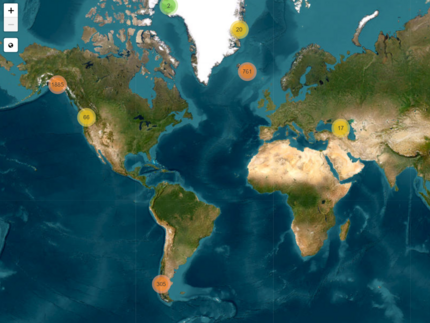Creating and maintaining a global database of glacier lake outburst floods
Project period:
2020 - ongoing
Project description:
Glacier lake outburst floods (GLOFs) have become an emblematic example of cryospheric change. These floods occur when the dams of glacial lakes suddenly fail. Since the 1990s, glacier lakes have increased by about 50%, warranting a closer look at how often, where and under what circumstances they burst out. A consistent GLOF inventory can therefore be an important source for assessing regional and local trends in GLOF occurrence, hazard and risk, in order to mitigate some of the catastrophic consequences for mountain communities, infrastructure and habitats. To this end, we continuously compile reports of GLOF events from literature and internet sources and implement each reported attribute into a standardised database. Our inventory includes 57 attributes that describe and quantify the location, dam type, size, timing and impact of GLOFs, with a particular focus on glaciated mountain regions outside the poles. We also provide details of the lake area before and after the outburst for cases mapped from Landsat, Sentinel-2, RapidEye and Planet imagery since 1984. To date, our inventory contains more than 4,000 GLOFs that occurred in 27 countries between 850 and 2024 AD - and it is still growing!
NW North America and Iceland are hotspots for GLOF reporting, but the density of reporting in our inventory varies as documentation depends on field reconnaissance or targeted remote sensing analysis. We are particularly interested in populating our database with hydrodynamic characteristics such as flood peak discharge or volume, or estimates of loss and damage, as these diagnostics are rarely reported. We are therefore dependent on local experts to contribute previously undocumented cases. Any report is highly appreciated!
Cooperation partners
We thank
- UP students Björn Wang, Jenny Tamm, Christoph Schmidt, Frederic Steppat, and Anika Zirzow who have collected data and mapped GLOF impacts in past years;
- numerous authors and database maintainers all over the world who have contributed data on historic GLOF occurrences.
Further information
For more information on the collection process and structure of our database, please see
- Lützow, N., Veh, G., and O. Korup, 2023: A global database of historic glacier lake outburst floods. Earth System Science Data, 15, 2983–3000, https://doi.org/10.5194/essd-15-2983-2023
Studies evaluating the global frequency and magnitude of glacier lake outburst floods include
- Veh, G., Wang, B.G., Zirzow, A., Schmidt, C., Lützow, N., Steppat, F., Zhang, G., Vogel, K., Geertsema, M., Clague, J.J., and O. Korup, 2025: Progressively smaller outbursts despite worldwide growth in lake area. Nature Water, doi.org/10.1038/s44221-025-00388-w
- Veh, G., Lützow, N., Tamm, J., Luna, L.V., Hugonnet, R., Vogel, K., Geertsema, M., Clague, J.J. and O. Korup, 2023: Less extreme and earlier outbursts from ice-dammed lakes since 1900. Nature, 614, 701–707, https://doi.org/10.1038/s41586-022-05642-9
- Veh, G., Lützow, N., Kharlamova, V., Petrakov, D., Hugonnet, R., and O. Korup, 2022: Trends, breaks, and biases in the frequency of reported glacier lake outburst floods. Earth's Future, 10, e2021EF002426. doi.org/10.1029/2021EF002426

